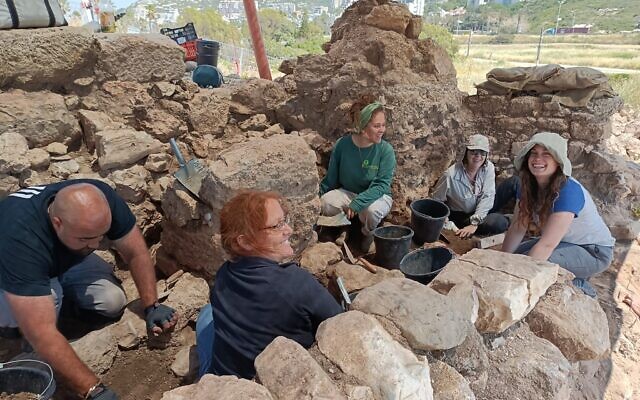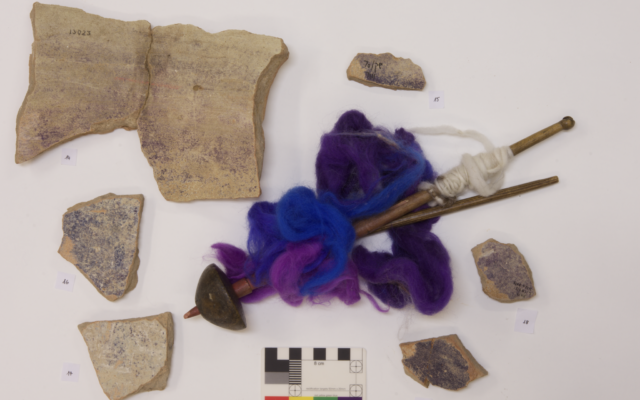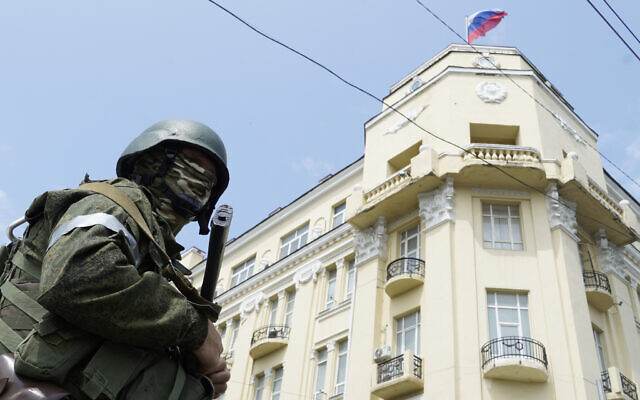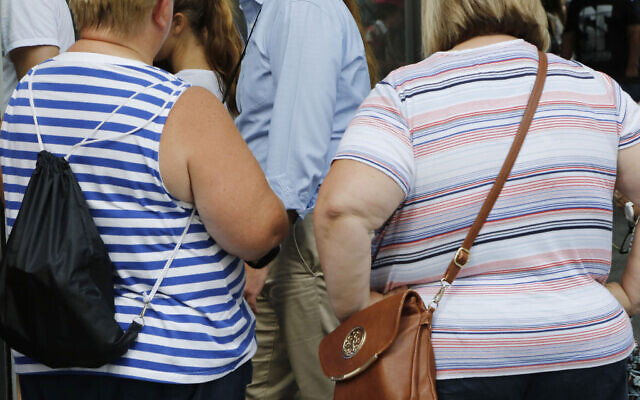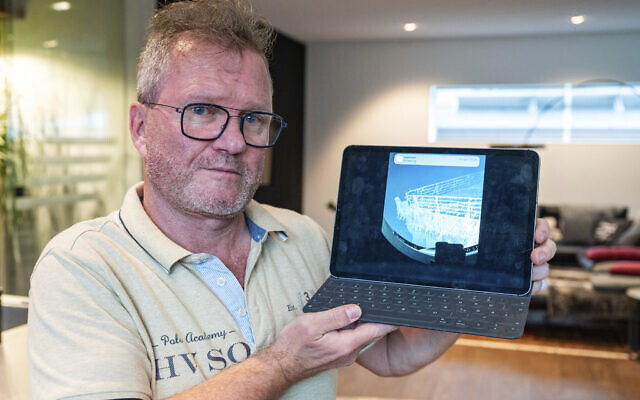Purple from Holy Temple objects traced to snail guts at 3,000-year-old Haifa factory
Archaeologists uncover new evidence at a Phoenician dye factory that suggests the site was conquered by Israelites around the mid-9th century BCE
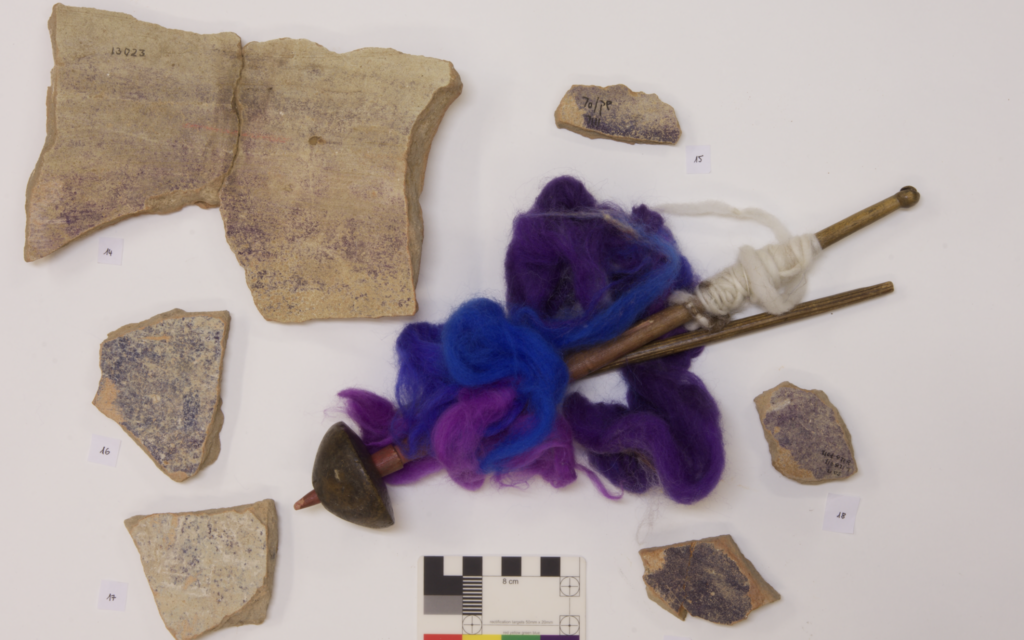 An example of fibers dyed using the purple color from sea snails. (courtesy Jonathan Gottlieb)
An example of fibers dyed using the purple color from sea snails. (courtesy Jonathan Gottlieb) Pieces of the ceramic vats that were used to hold the purple dye excavated at Tel Shiqmona still hold traces of the color. (courtesy Golan Shalvi)
Pieces of the ceramic vats that were used to hold the purple dye excavated at Tel Shiqmona still hold traces of the color. (courtesy Golan Shalvi)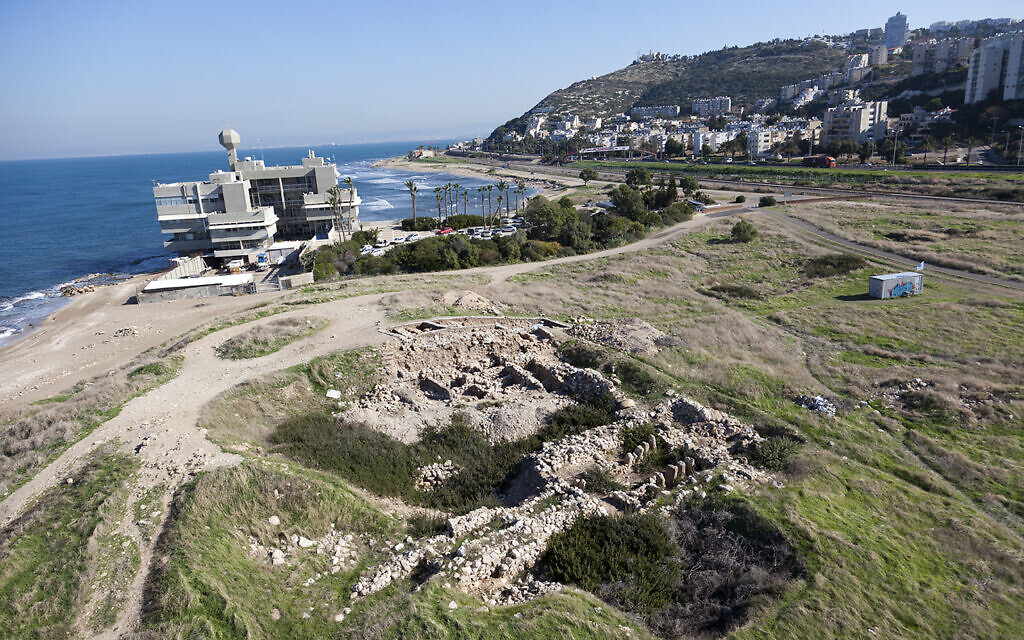 Tel Shiqmona in southern Haifa is the site of a 3,000-year-old purple dye factory. (courtesy Michael Eisenberg)
Tel Shiqmona in southern Haifa is the site of a 3,000-year-old purple dye factory. (courtesy Michael Eisenberg)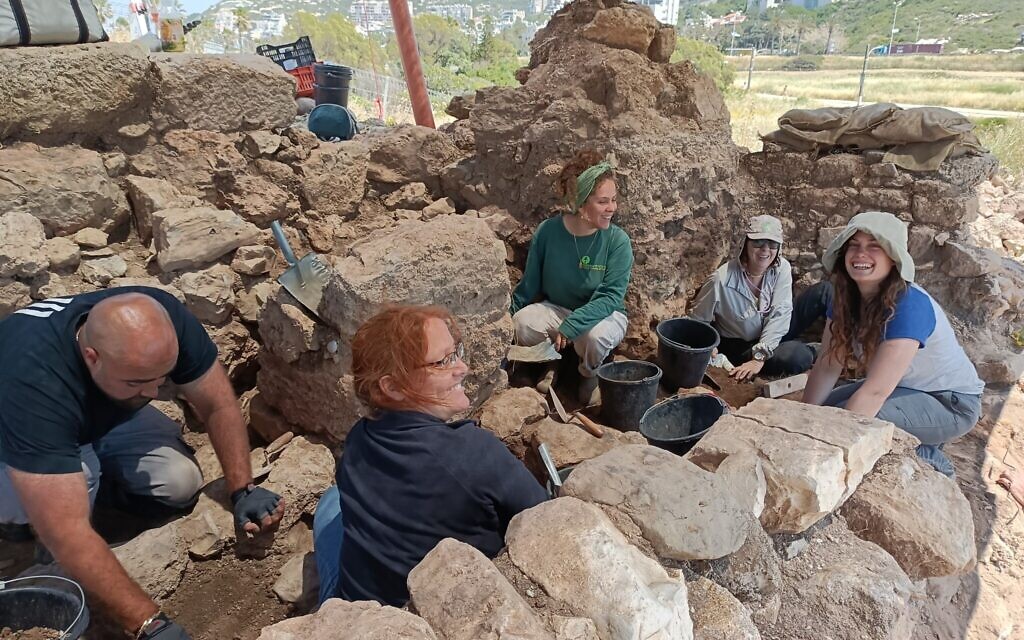 Excavations of the Tel Shiqmona site in Haifa in 2023. (courtesy Golan Shalvi)
Excavations of the Tel Shiqmona site in Haifa in 2023. (courtesy Golan Shalvi) Reconstructed Phoenician pottery excavated from Tel Shiqmona. (courtesy University of Haifa)
Reconstructed Phoenician pottery excavated from Tel Shiqmona. (courtesy University of Haifa)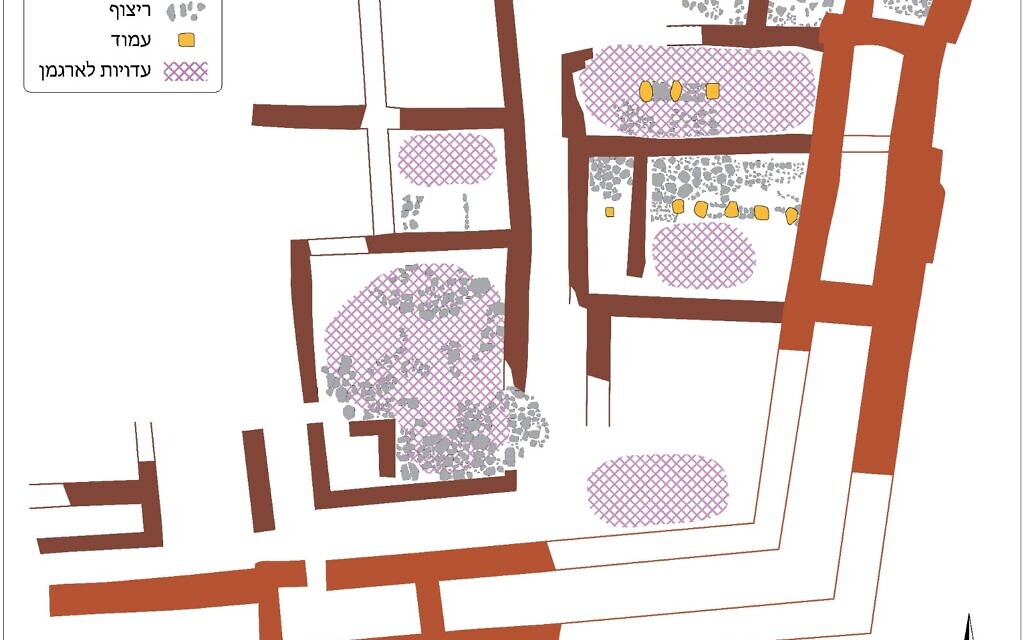 A map of the Tel Shiqmona site which shows areas where evidence of purple dye was found. (courtesy University of Haifa)
A map of the Tel Shiqmona site which shows areas where evidence of purple dye was found. (courtesy University of Haifa)
The scarlet, purple, and sapphire hues that adorned curtains and robes at the Holy Temple in Jerusalem likely came from sea snails processed at a 3,000-year-old dye factory in modern-day Haifa, archaeologists recently announced after discovering new evidence at the Tel Shiqmona site.
The new research suggests the Israelites may have conquered the factory from the Phoenicians to obtain more access to the expensive purple dye and create wealth for the growing empire. An article describing it, “Between Israel and Phoenicia: The Iron IIA–B Fortified Purple-dye Production Centre at Tel Shiqmona,” was published earlier this month in the peer-reviewed Journal of the Institute of Archaeology of Tel Aviv University.
The purple dye is created from a gland found in three kinds of sea snails, commonly called rock snails or murex, found along Israel’s coast. The dye likely created both the argaman (purple) and techelet (blue) referred to in the Hebrew Bible. The color is so strong that it can stay fixed for thousands of years, meaning dyed fibers from 3,000 years ago maintain their vibrant hue.
Depending on how long the purple color was exposed to the sun during the production process, the color of the dye can range from bright blueish green to a deep, purplish red.
“This color of purple never fades, and the technology that enables the dyeing of fibers was probably invented in the Levant, though people usually ascribe it to Lebanese Phoenicians,” said Prof. Ayelet Gilboa of the University of Haifa, who led the study with Dr. Golan Shalvi, a research fellow in the Zinman Institute of Archaeology in the University of Haifa.
Purple is traditionally considered the color of royalty because of the expense of creating the dye from these sea snails.
“It was used for the parochet [curtain of the Holy Ark in the Temple], and the elite were wearing clothing that incorporated purple fibers, that included the high priests, the king, and really anyone who had money,” said Gilboa.
The purple dye is often referred to as “Tyrian Purple” because it is thought to have originated in the Phoenician seaside city of Tyre, in modern-day Lebanon. Its production was one of the major economic engines for the Phoenicians. Tyre is about 50 kilometers (30 miles) north of Haifa and 80 kilometer (50 miles) south of Beirut.
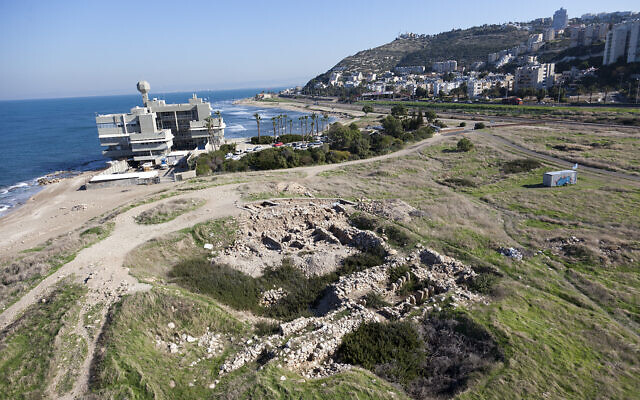
Roman historian Vitruvius expounded on the color in his opus “10 Books on Architecture” published around 27 BCE, around 1,000 years after the Tel Shiqmona factory had already been in production.
I shall now speak of purple, which, above all other colors, has a delightful effect, not less from its rarity than from its excellence. It is procured from the marine shell which yields the scarlet dye, and possesses qualities not less extraordinary than those of any other body whatever. It does not in all places where it is found possess the same quality of color; but varies in that respect according to the sun’s course.
A factory destroyed and rebuilt
The dye factory is located at Tel Shiqmona on the southern end of Haifa’s coast. The settlement remains had previously confounded archaeologists: It was first settled in the Bronze Age, around 1500 BCE, but was quite small compared to other settlements at the time. It was also located far from agricultural lands and next to an area of rocky coast that was unlikely to be useful for maritime trade.
Dr. Yosef Elgavish first excavated the site in the 1960s and 1970s and discovered large ceramic vats that were dyed purple and a large amount of Phoenician pottery. He proposed that the site had some role in the production of the purple dye, but didn’t delve into the amount of production or who ran the dye process.
More recent excavations over the past five years led by archaeologists Gilboa and Shalvi, who is also a postdoctorate fellow at Ben Gurion University, found evidence of Israelite settlement that led them to believe that the site was conquered by the Kingdom of Israel around the mid-9th century BCE.
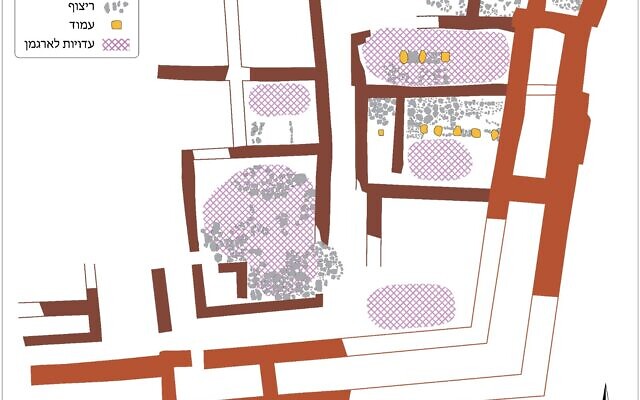
Around the time the biblical King Ahab ascended the throne, the dye factory was destroyed and rebuilt. The archaeologists found Phoenician pottery from after the rebuild, showing that Phoenicians were likely still living there. They also uncovered Israelite-style fortified walls, Israelite seals and four-room houses that were common to Israelite architecture at the time. These discoveries, combined with historical texts and understandings about the geopolitical situation at the time, led them to hypothesize that the site was under Israelite rule but Phoenicians still carried out the day-to-day labor.
“You really need to be a person who understands the sea, and this is knowledge that is passed through the generations, much earlier than Israelites came into power,” said Shalvi. “Israelites are people of the interior, of the highlands, not of the sea.”
The color of money
“This color was one of the most commercially expensive things available and really created a lot of wealth,” Shalvi explained. “This is also a color that has a historical and holy meaning for the Jews.”
He noted that several historical accounts from this period mention the Kingdom of Israel’s military and economic strength, but these excavations illustrate concretely how the kingdom was able to identify an economic opportunity as it expanded northwards, and monopolize it for local production.
“It enlarges our understanding of the picture from a practical perspective and helps explain how the Israelites achieved this level of economic strength,” Shalvi said.
“This is the best place along the Israeli coast with the best habitat for the snails that produce the dye,” said Gilboa. “Here, the Carmel Ridge continues into the sea, so the surface of the rocks underwater is quite high and it’s very easy to access the shells.”
The true purple argaman dye and its associated azure techelet variant are mentioned dozens of times in the Hebrew Bible and Sennacherib’s Cylinder (690 BCE), among other texts.
True purple is associated with royalty and the priesthood, as well as textiles used in the Tabernacle and the Temple. “And you shall make a dividing curtain of blue, purple, and crimson wool, and twisted fine linen; the work of a master weaver he shall make it, in a [woven] cherubim design” (Exodus 26:30-31).
In 2021, Israeli researchers announced the discovery of three textile scraps near the southern tip of Israel colored with the biblically described argaman royal purple dye, and dated them to circa 1,000 BCE — the era of King David. These purple fibers are currently the oldest known example of the purple dye discovered in Israel, as the discoveries from Tel Shiqmona date to a few centuries later.
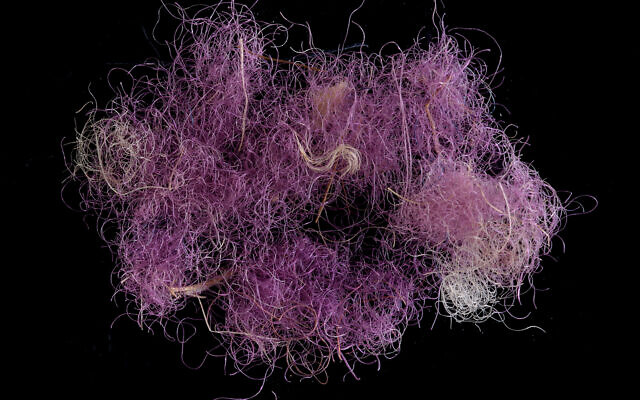
The dye is created from three types of sea snails found on this Israeli coast, the spiny dye-murex (Murex brandaris); banded dye-murex (Murex trunculus), and red-mouthed rock-shell (Murex haemastoma). The banded-dye murex is the most plentiful and accounted for the majority of the dye, Gilboa said.
A special exhibit at the Bible Lands Museum in Jerusalem in 2018 called “Out of the Blue” exhibited some of the murex trunculus snail shells excavated at the Tel Shiqmona site. The holes in the shells show where the gland from the snail was extracted, with each yielding only a minuscule amount of the rare and highly coveted pigment.
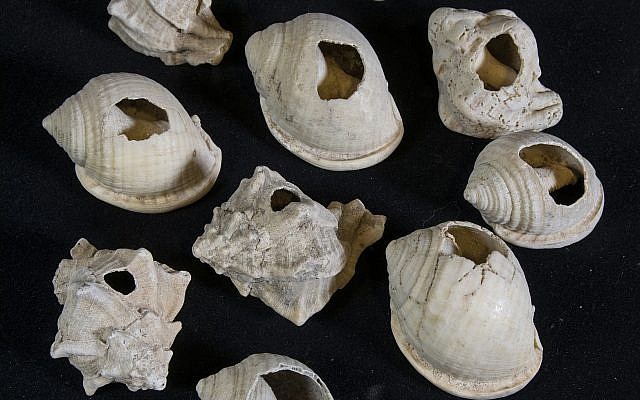
Each gland produces less than a gram of dye, so for a single kilogram of dye, thousands or even tens of thousands of snails are needed. Some experts from the Ptil Tchelet organization, which produces talit fringes from the murex, believe that the dye was worth up to 20 times its weight in gold.
“This place was very active, and very productive,” said Gilboa. “Shiqmona is the only place that we know where it was not a village producing small amounts of dye, but the whole site was a factory.”
There may have been another reason for the lack of residences in the area, one that modern Haifa residents know all too well: an intolerable stench from the factory.
“Phœnicians, in general, have always excelled all nations, and by (the export of) purple-dyed manufactures, the Tyrian purple being in the highest estimation,” wrote Strabo, the Greek geographer and historian, who lived from 64 BCE to 21 CE. “The shellfish from which it is procured is caught near the coast, and the Tyrians have in great abundance other requisites for dyeing. The great number of dyeing works renders the city unpleasant as a place of residence, but the superior skill of the people in the practice of this art is the source of its wealth.”
There's no paywall on The Times of Israel, but the journalism we do is costly. As an independent news organization, we are in no way influenced by political or business interests. We rely on readers like you to support our fact-based coverage of Israel and the Jewish world. If you appreciate the integrity of this type of journalism, please join the ToI Community.

We’re really pleased that you’ve read X Times of Israel articles in the past month.
That’s why we started the Times of Israel eleven years ago - to provide discerning readers like you with must-read coverage of Israel and the Jewish world.
So now we have a request. Unlike other news outlets, we haven’t put up a paywall. But as the journalism we do is costly, we invite readers for whom The Times of Israel has become important to help support our work by joining The Times of Israel Community.
For as little as $6 a month you can help support our quality journalism while enjoying The Times of Israel AD-FREE, as well as accessing exclusive content available only to Times of Israel Community members.
Thank you,
David Horovitz, Founding Editor of The Times of Israel


